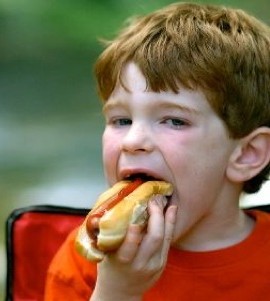Do we need to reinvent the hotdog?

This past week, the American Academy of Pediatrics (AAP) released new guidelines in the March 2010 issue of Pediatrics for the prevention of choking in childhood. As a Fellow of the AAP, I felt it important to publish this information as a public service and educational opportunity.
Choking is a leading cause of injury and death among children, especially for those 3 years old or younger. Food, coins, and toys are the primary causes.
In 2000, 160 children ages 14 years or younger died from an obstruction of the respiratory tract due to inhaled or ingested foreign bodies. Of these, 41% were caused by food items.
For every choking-related death, there are more than 100 non-fatal visits to U.S. emergency rooms. In 2001, an estimated 17,537 children 14 years or younger were treated in U.S. emergency departments for choking episodes. Of these visits,60% were associated with food items. Candy accounted for about 20% of the food items- hard candy being the most common. Coins were involved in another 20% of incidents. Hot dogs were responsible for 17% of food related deaths.
Why are kids more prone to choking?
 1.The pediatric airway is anatomically different. It is:
1.The pediatric airway is anatomically different. It is:
- Smaller and more flexible than an adult.
- The tongue is proportionately larger.
- The epiglottis is floppy and round.
- The vocal cords slant upward, and are closer to the base of the tongue.
- Narrowest part is at the cricoid cartilage at the bottom- which makes the airway funnel-shaped.
2. Young children commonly put objects in their mouths as they explore their environment.
3. The ability to chew and swallow their food is not well developed.
Certain characteristics, including shape, size, and consistency, of certain toys and foods increase their potential to cause choking among children:
A hot dog shares the physical characteristics as for high-risk toys. It is cylindrical, airway sized, and compressible, which allows it to wedge tightly into a child’s throat and completely obstruct the airway. Other high-risk foods include hard candy, peanuts/nuts, seeds, whole grapes, raw carrots, apples, popcorn, chunks of peanut butter, marshmallows, chewing gum, and sausages.
The CDC (Centers for Disease Control) states that every child is at risk of choking. To reduce this risk, parents and caregivers should:
- keep a watchful eye on their children when eating and playing;
- keep dangerous toys, foods, and household items out of reach; and
- learn how to provide early treatment for children who are choking.
The AAP’s recommends:
- Warning labels on foods that pose a high choking risk.
- A recall of food products that pose a significant choking hazard.
- The establishment of a nationwide food-related choking-incident surveillance and reporting system.
- Food manufacturers should design new food and redesign existing food to minimize choking risk.
- CPR and choking first aid should be taught to parents, teachers and child care providers.
For instructions on how to do first aid for choking infants and children click here- Infant Child
For more information:
| Resounding Health(tm) Choking in Children |
























0 comments